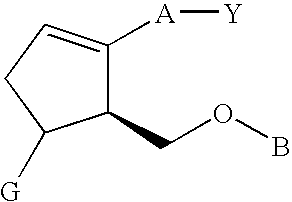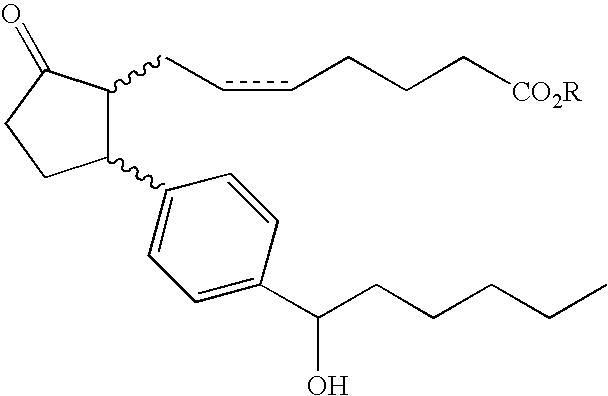Substituted arylcyclopentenes as therapeutic agents
a technology of arylcyclopentin and arylcyclopentin, which is applied in the direction of drug compositions, heterocyclic compound active ingredients, biocide, etc., can solve the problems of pupilar blockage, acute attack, and impeded drainage of aqueous humor, and achieve the effect of increasing viscosity
- Summary
- Abstract
- Description
- Claims
- Application Information
AI Technical Summary
Benefits of technology
Problems solved by technology
Method used
Image
Examples
example 2
[0199]Tetrakis(triphenylphosphine)palladium(0) (20 mg, 0.017 mmol) and pyrrolidine (14 μL, 0.17 mmol) were added sequentially to a solution of allyl ester 12 (30 mg, 0.058 mmol) in CH2Cl2 (1.0 mL). After 5 min the reaction mixture was partitioned between 1.0 M aqueous HCl (5 mL) and CH2Cl2 (15 mL). The phases were separated and the aqueous phase was extracted with CH2Cl2 (2×10 mL). The combined extracts were washed with brine (10 mL), dried (MgSO4), filtered and concentrated in vacuo. Purification of the crude residue by flash column chromatography on silica gel (60% EtOAc / hexane) afforded 9 mg (33%) of compound 15.
[0200]Compound 15 can be converted to compounds 16a or 16b according to the steps outlined in Example 1, Step 4.
Step 1. Hydrolysis of 17 to Give 18
[0201]Ester 17 (see U.S. Provisional Patent Application No. 60 / 757,696, filed Jan. 10, 2006; 200 mg, 0.343 mmol) was converted into 140 mg (57%) of hydroxy-acid 18 in accordance with the procedure of Example 1, step 3.
Step 2. ...
example 4
Step 1. Mitsunobu Reaction of 23 to Give 24
[0206]Triphenylphosphine (38 mg, 0.14 mmol) and DIAD (23 μL, 0.12 mmol) were added to a solution of alcohol 23 (see U.S. Provisional Patent Application No. 60 / 805,285, filed Jun. 20, 2006, incorporated by reference herein; 40 mg, 0.096 mmol) and 3,5-dichlorophenol (23 mg, 0.14 mmol) in CH2Cl2 (1.0 mL). After stirring 18 hours at room temperature, the mixture was partitioned between CH2Cl2 (10 mL) and saturated aqueous NaHCO3 (10 mL). The phases were separated and the aqueous phase was extracted with CH2Cl2 (2×10 mL). The combined organic phase was washed with brine (10 mL), dried (MgSO4), filtered and concentrated in vacuo. Purification of the residue by flash column chromatography on silica gel (hexane→EtOAc, gradient) afforded 20 mg (37%) of 24.
Step 2. Deprotection of 24 to Give 27
[0207]Pyridinium p-toluenesulfonate (PPTs, 1 mg, 0.004 mmol) was added to a solution of 24 (20 mg, 0.036 mmol) in methanol (0.35 mL) at room temperature. The ...
example 5
[0210]Ester 28 (see U.S. Provisional Patent Application No. 60 / 805,285, filed Jun. 20, 2006; 30 mg, 0.058 mmol) was converted into 13 mg (49%) of compound 31 in accordance with the procedure of Example 4, step 3. Compound 31 can be converted to compounds 34a or 34b according to the steps outlined in Example 1, Step 4.
PUM
| Property | Measurement | Unit |
|---|---|---|
| Structure | aaaaa | aaaaa |
| Pharmaceutically acceptable | aaaaa | aaaaa |
Abstract
Description
Claims
Application Information
 Login to View More
Login to View More - R&D
- Intellectual Property
- Life Sciences
- Materials
- Tech Scout
- Unparalleled Data Quality
- Higher Quality Content
- 60% Fewer Hallucinations
Browse by: Latest US Patents, China's latest patents, Technical Efficacy Thesaurus, Application Domain, Technology Topic, Popular Technical Reports.
© 2025 PatSnap. All rights reserved.Legal|Privacy policy|Modern Slavery Act Transparency Statement|Sitemap|About US| Contact US: help@patsnap.com



